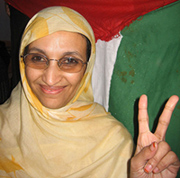POGROMS, PARANOIA AND POLLING IN INDIA
A Muslim Woman Confronts Her Fear of Voting—Eight Years After the Gujarat Massacres
by Subuhi Jiwani, Sarai Reader
The dot on my index finger nail has been moving stealthily towards the edge. It is the show-sign of patriotism. I have voted, and this is supposed to make me a good Indian. The television commercials for the Jaago Re! One Billion Votes campaign, broadcast before the elections, insist that you’re sleeping if you don’t vote, that you aren’t actualizing your existence. They’re niftily crafted and catchy, and they stirred me. At 29, I had this niggling feeling that I was an apolitical, bourgeois citizen who hadn’t exercised her right to participate in democracy.
However, it wasn’t the sudden realization of unfulfilled political duties or steadfast national pride that had awoken me. I’d been awake—wide-eyed, shaken-out-of-my-sleep awake—since late February 2002. I registered to vote because I was afraid of a Hindu nationalist party coming to power in Maharashtra or at the Centre; of Gujarat 2002 happening in Mumbai; of being a number among the riot toll of Muslim women raped or maimed or killed in the streets. This fear had multiplied itself within me and grown another organism: the fear of being on the electoral roll.
I had lived through the 1992-93 riots in Bombay (then the city’s name) as a young girl on the cusp of puberty. Initially, I was disgruntled that people in faraway Ayodhya had decided to tear down a mosque on my birthday. After a rather damp morning of Cadbury chocolate distribution, I returned home feeling deprived of an entire day of wishes and attention. I remember taking the Andheri flyover highway that morning and thinking, “It’s never been this empty before.” There was a perceptible atmosphere of gloom, of confusion, and I felt the beginnings of fear. But it was soon replaced by the thrill of no school for three months and endless games of relay in the building compound. In fact, escaping my building’s boundaries became particularly exciting because my parents had strictly prohibited it. I knew that something was amiss because uncles would guard the building at night with cricket bats, and my mother had given me a Christian name, just in case someone asked. But it was not my time for sleepless nights.
Gujarat 2002 has been the most egregious and therefore the most memorable communal carnage of my adult life. I had witnessed it remotely, from my laptop in an overheated apartment in Brooklyn. I had accessed news websites online but hadn’t sought out video content. I had read: madly, obsessively, half-shivering, half-crying. At the time, I had just started writing for World War 4 Report, an independent, leftist e-journal that my editor, Bill Weinberg, ran out of his living room in the Lower East Side. I did mostly secondary-source news collation and spent hours each night after work ploughing through countless Google searches and reading articles about Gujarat in the mainstream and independent Indian press. I had printed out Smita Narula’s 70-page report for Human Rights Watch, “We Have No Orders to Save You”: State Participation and Complicity in Communal Violence in Gujarat, and kept it on my bedside table as necessary reading. I would force myself to read it every night, even though I struggled to get past the first few paragraphs.
I felt like a victim in absentia whose feelings of betrayal echoed those she could hear in the testimonies of Gujarat’s survivors. I heard the sounds of my romanticized notions of syncretic India being crushed. I hadn’t grown up thinking “these people” were “my people,” but suddenly I felt like a fish forced into a plastic bag while its bowl was being cleaned. I had waited with as much anticipation for the next episode of Mahabharat on Sunday mornings as any other kid in my building. My mother had worn a big kumkum bindi on her forehead for as long as I could remember. I had loved the color and magic and myth of Hinduism and, like a child whose ball is snatched from her, I felt crudely severed from it. I would repeat in my head the clichés one hears from miffed lovers on discovering that their partners have cheated on them: “I loved you, how could you do this to me?”
The fear that the porous and permeable dotted line between “us” and “them” had become impenetrable and double-bolded first made me articulate an ambivalent minority-hood in the diaspora. I was on an H1-B visa and working a dead-end job at a shelter for abused women and children. I eventually decided to leave New York and return to Mumbai, but the fear lingered on: could Mumbai become another Gujarat?
I’d shared these concerns with my mother over the phone in the months before I returned home. She had shrugged them off just as she did my fear of being on the electoral roll. “They tracked down the Muslims in Gujarat from the voter lists!” I’d exclaim in one of our many heated discussions. Her reply: “I’ve had my Muslim name on voting lists for 60 years, Subuhi, and nothing has happened!”
If nothing has happened, then my fear must be irrational, an outcome of an over-anxious mind. That’s the unspoken refrain I hear every time I confide in someone about this. A Gujarati Hindu friend recently came back with this retort: “You’re falling into the trap of minority-hood.” She reminded me of the classic argument of how class will protect me. Rioting only happens in the bastis, in the slums, to the poor, the uneducated. It is spontaneous, unplanned. It is the result of sudden political upheavals.
I try to explain that cooking gas cylinders were hoarded in Ahmedabad for weeks before the pogrom, which, by all indications, was premeditated. It was the outcome of anti-Muslim sentiment, which has been nurtured and brewed by Hindutva Vadi forces. I am met with retorts that point to the planned nature of Islamist violence and its roots in a deeply entrenched fundamentalism. Such arguments devolve into matches of Your Fundamentalism versus My Fundamentalism, and usually end on a predictably liberal note that underlines the tolerance of all religious systems and decries their “corruption” by politically motivated parties. I persist with arguments about the politicized nature of everything—religious philosophies, social movements, knowledge systems, interpersonal relationships, etc. This Marxist critique, applicable as it is to most social institutions and structures, takes the discussion away from the particular and into the universal. I am no closer to articulating a sentient theory about the experience of majoritarianism. I fumble, trip, digress and fall over my words.
I’ve decided to return to my fear, to understand before I can extrapolate. I’m cognizant of the fact that I am not overtly marked as Muslim, like someone whose last name is Khan or Sheikh. I don’t wear any visible markers of Muslim-ness, and it is not an integral part of my identity, culturally or spiritually. I have gone as far as writing newspaper op-eds about how Eid is uneventful in our home, a date on the calendar like any other. In addition, I have often skirted the “What are you?” question, and insisted that I am agnostic, disassociating myself from any socio-religious or spiritual history. But the electoral roster, when I finally looked at it, had a number of Mohammed and Sharifa Jiwanis before and after my name. While Islam is just something I inherited, I am Muslim by association on the electoral roll, whether I like it or not.
My decision to vote finally came from the desire to push myself into accepting that, try as I might, I cannot resist being tagged Muslim. It is on my birth certificate, in my passport and my family ration card. Like race and gender, our religious identities cannot be circumvented, however incidental they may be to the construction of our selves. They need not entrap us, however, and perhaps we can, with our particularities, break through their bondage and the essentialisms they force on us.
I landed on a revelation when I finally went to the electoral office in 2009 with a filled-out application form for my voter identity card. The electoral officer said to me in disaffected Marathi, “But, madam, your name is already on the list.” My fear had induced amnesia about the time when I was so angry about the Gujarat betrayal that I felt the only way I could overcome it was by voting out the possibility of a saffron government in Maharashtra and the Centre. It was a drizzly afternoon in 2004, a month after I had returned to Mumbai from New York, when I had tracked down the election office in Andheri’s concrete maze, handed in my form, and was formally written into the voter lists. It had slipped out of my mind, the way an ATM cash withdrawal receipt gets lost in my wallet, in the clutter of bills, Halls wrappers and bits of paper.
Did I simply forget the fear which projected itself as anger, a shudder deep inside my chest that threatened to explode? It ticked time bomb-like each time I passed a Shiv Sena shakha (public office), or saw forked saffron flags waved around during Ganpati Visarjan, the festival honoring the Hindu god Ganesh. I lived with it alone, and if I tried to share it, I was reminded of its irrationality. My class, it seemed, was immune to such fears, and the Shi’a Imami Ismaili community was as alien to me as farmers on the American prairie. My self-groomed cosmopolitanism had made me areligious and isolated, and my fear was driven into the ground with a shovel.
In a Kill Bill II moment, it re-emerged from its coffin in early 2008. It was my first semester as a Master’s student at the Tata Institute of Social Sciences. Journalist Sameera Khan had been invited to speak about Muslim identity. Of the many experiences she shared, I was moved by the story of how her family had to take shelter from a mob during the 1992 riots. They lived at a neighbor’s house for four days—hidden, in fear.
This was the first time I had heard an upper-middle class, Western-educated Muslim woman articulate that which I’d quietened so long ago. Images of poor, crying Muslim victims of the carnage were ubiquitous in documentaries and news; these were pictures of affect. The subterranean shivers and exigencies of the “unaffected” seemed rarely to find voice in
public fora.
The events that had spurred on our fears were from different decades; the nature and handling of our fears were different; but fears they were, finally united and echoing each other. Sameera had seemingly tabled her fear, and forced a predominantly Hindu audience to acknowledge a history of communal violence and majoritarianism. I felt less alone in my fear, less convinced of its irrationality, but reminded of it nonetheless.
Fear may be a confrontation with the unknown and the confusion that results from this meeting. In order to grapple with this unknowing, we translate it in terms of the known, in terms of memory. What has been leaves its imprint on us; it makes us and our present. We cannot predict what will be but want to, and this reflects our deep-seated desire to know and control. The impulse that drives institutions to obtain knowledge, classify, taxonomize, experiment and, finally, prognosticate has also trickled down to the individual. If we cannot know what the future will hold, we fill the gaps with our anxieties and extrapolate.
Indeed, un-knowing has inspired my own fears. And the inability to answer the following questions: will a Hindu nationalist party come to power? If so, will it instigate communal violence? Will I be caught up in it and become vulnerable? I’ve translated the insecurity that results from not being able to predict the future into a self-induced victimization. This essay grew out of the desire to admit my fears publicly, to share them with an audience and, perhaps, overcome them through articulation. In reality, it has been an attempt to control and rationalize them.
I would like to think, though, that the dot on my nail has brought me a little closer to submitting myself to the unknown. Honestly, though, that’s the logical me speaking. These days, I don’t get as nervous when I have to answer the “What kind of name is that?” question. If I am to be categorized, labelled, boxed or stereotyped, that’s about as unavoidable as the malleability of water. I do, however, wonder if a communal conflagration can flare up in a snap second. This worry, which inhabits a subliminal space, prevents me from divulging my religious identity to strangers or people I barely know. When the guy who runs a copying shop near my house asks me where I’m from, I usually say “Bombay” (still the city’s street name) and end it there. The local Shiv Sena corporators also give him business, and he might, at some point in the future, have to choose sides. In that moment, I’d like to slip though the gap.
—-
Subuhi Jiwani is a writer and researcher based in Mumbai.
This article first appeared in the February edition of the Delhi-based journal Sarai Reader under the title “SCARE QUOTES: Who’s Afraid of Voting? The Inexpressible Nature of Some Fears.” This version was slightly edited by World War 4 Report.
Resources:
“We Have No Orders to Save You”: State Participation and Complicity in Communal Violence in Gujarat
Smita Narula, Human Rights Watch, 2002, New York
Fascism’s Firm Footprint in India
Arundhati Roy, The Nation, Sept. 30, 2002
Online at Third World Traveller
From our Daily Report:
India: terror targets Muslims in Gujarat, Christians in Karnataka
World War 4 Report, Sept. 30, 2008
New violence at Ayodhya
World War 4 Report, July 5, 2005
From our archive:
Hindu right exults in Gujarat victory
World War 4 Report, Dec. 23, 2002
——————-
Reprinted by World War 4 Report, June 1, 2010
Reprinting permissible with attribution



